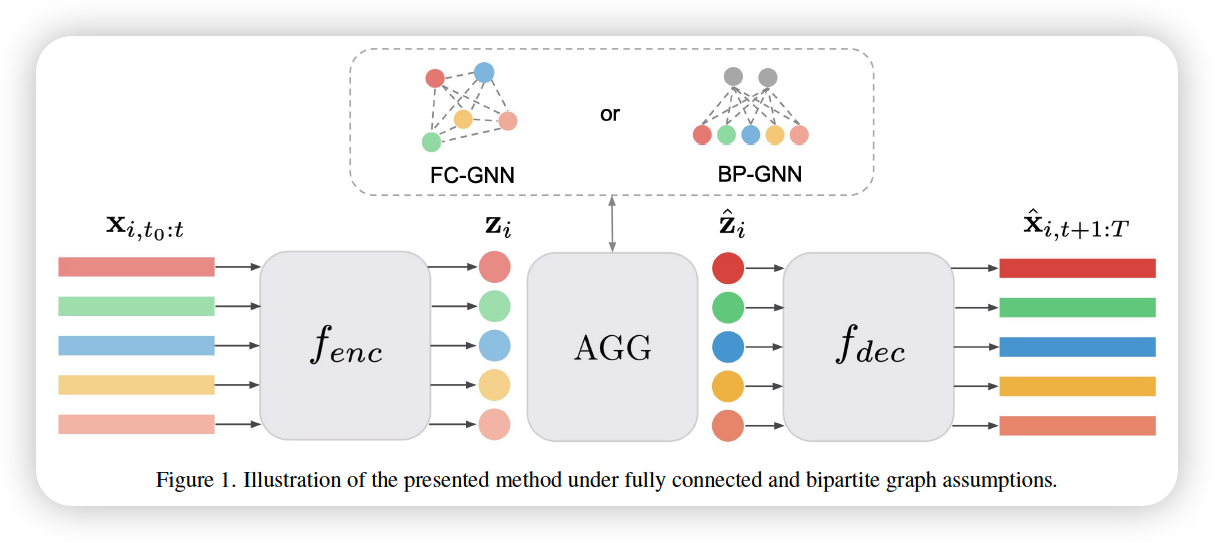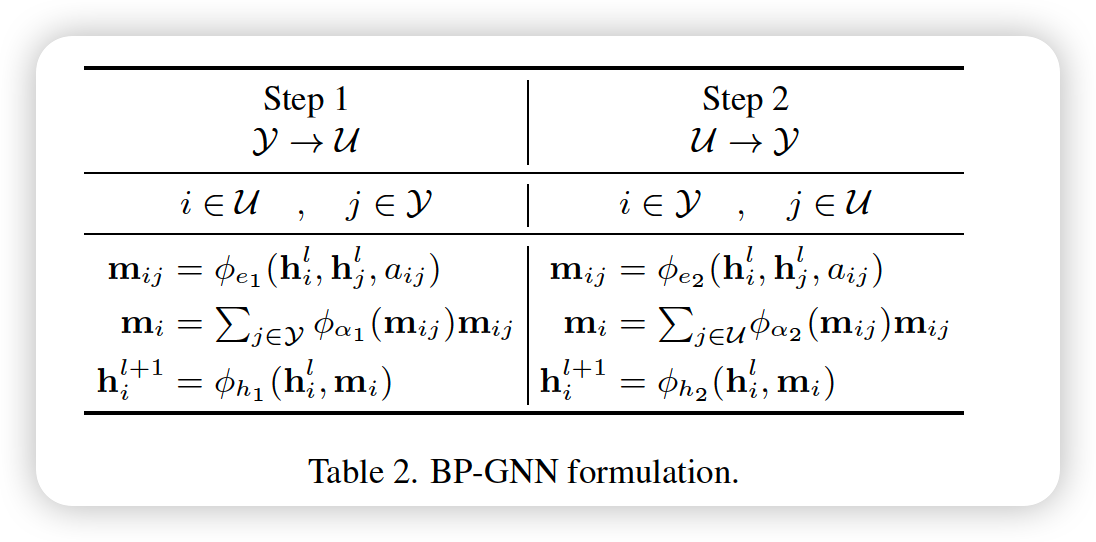MTS forecasting with Latent Graph Inference (2021)
Contents
- Abstract
- Introduction
- Method
- FC-GNN
- BP-GNN
0. Abstract
-
jointly infers and leverages relations among time series
-
allows to trade-off accuracy and computational efficiency gradually
- extreme 1 : potentially fully connected graph
- consider all pair-wise interactions
- extreme 2 : bipartite graph
- leverages the dependency structure, by inter-communicating the \(N\) TS through a small set of K auxiliary nodes
- extreme 1 : potentially fully connected graph
1. Introduction
inferring all pairwise relations : high computational costs ( \(O(N^2)\) )
\(\rightarrow\) propose a new LATENT GRAPH INFERENCE algorithm
- easy to implement on current univariate model
- complexity :
- (1) fully connected : \(O(N^2)\)
- (2) bipartite : \(O(NK)\)
2. Method
2 families of forecasting method
- (1) Global Univariate models
- (2) Multivariate models
This algorithm
-
cast this algorithm, as a modular extension of univariate case
-
Break down univariate model into 2 steps : \(f_{u}=f_{e n c} \circ f_{d e c}\)
- \(\mathbf{x}_{i, t_{0}: t} \stackrel{f_{\text {enc }}}{\longrightarrow} \mathbf{z}_{i} \stackrel{f_{\text {dec }}}{\longrightarrow} \hat{\mathbf{x}}_{i, t+1: T}\).
-
include a multivariate aggregation module \(A G G\) ,
between \(f_{e n c}\) and \(f_{d e c}\)
that propagate info among nodes in latent space \(\mathbf{z}=\left\{\mathbf{z}_{1}, \ldots, \mathbf{z}_{N}\right\}\)
\(\rightarrow\) \(\hat{\mathbf{z}}=\mathrm{AGG}(\mathbf{z})\)
( this new embedding is passed to decoder )
\(\begin{aligned} \text { Univariate Encoder } & \mathbf{z}_{i}=f_{e n c}\left(\mathbf{x}_{i, t_{0}: t}, \mathbf{c}_{i}\right) \\ \text { Multivariate extension } & \hat{\mathbf{z}}=\mathrm{AGG}(\mathbf{z}) \\ \text { Univariate Decoder } & \hat{\mathbf{x}}_{i, t+1: T}=f_{d e c}\left(\hat{\mathbf{z}}_{i}\right) \end{aligned}\).
- overall model : multivariate
- but \(f_{e n c}\) and \(f_{d e c}\) : univariate
Does not propagate information among nodes at every time step,
but only in the AGG module \(\rightarrow\) CHEAPER!!!

(1) FC-GNN
-
complexity : \(O(N^2)\)
-
fully connected graph : \(\mathcal{G}=\{\mathcal{V}, \mathcal{E}\}\)
- \(e_{i j}=1\) for all \(e_{i j} \in \mathcal{E}\)
-
\(\mathbf{z}_{i}\) ( embedding of TS \(i\) ) is associated with \(v_{i} \in \mathcal{V}\)
\(\rightarrow\) directly use GNN model as AGG
\(\rightarrow\) the output node embedding \(\mathbf{h}_{i}^{L}\) is provided as the input \(\hat{\mathbf{z}}_{i}\) to decoder
-
attention weights \(\alpha_{i j} \in(0,1)\) for each edge
-
“gate” the exchanged messages \(\mathbf{m}_{i}=\sum_{i \neq j} \alpha_{i j} \mathbf{m}_{i j}\)
( = dynamically inferring the graph )
( = just like \(\mathbf{m}_{i}=\sum_{j \in \mathcal{N}(i)} \mathbf{m}_{i j}=\sum_{j \neq j} e_{i j} \mathbf{m}_{i j}\) )
-
\(\sum_{i \neq j} e_{i j} \mathbf{m}_{i j} \approx \sum_{i \neq j} \alpha_{i j} \mathbf{m}_{i j}\) : can view it as
- soft estimation \(\alpha_{i j}=\phi_{\alpha}\left(\mathbf{m}_{i j}\right)\)
-
(2) BP-GNN
- complexity : \(O(N K)\) …. \(K <<N\)
- bipartite graph : \(\mathcal{G}=(\mathcal{Y}, \mathcal{U}, \mathcal{E})\)
- \(\mathcal{Y}\) : set of \(N\) nodes
- associated embeddings : \(\mathbf{z}=\left\{\mathbf{z}_{1}, \ldots \mathbf{z}_{N}\right\}\)
- \(\mathcal{U}\) : set of \(K\) auxiliary nodes
- associated embeddings : \(\mathbf{u}=\left\{\mathbf{u}_{1}, \ldots \mathbf{u}_{K}\right\}\)
- \(\mathcal{E}\) : edges, interconnecting all nodes between the two subsets \(\{\mathcal{Y}\), \(\mathcal{U}\}\)
- but no connections among nodes within the same subset
- total of \(2NK\) edges
- \(\mathcal{Y}\) : set of \(N\) nodes
- input to GNN : union of 2 node subsets \(\mathcal{V}=\mathcal{Y} \cup \mathcal{U}\)
- input embedding : \(\mathbf{h}^{0}=\mathbf{z} \mid \mid \mathbf{u}\)
- asynchronous schedule
- (1) information is propagated from TS nodes to Auxiliary nodes ( \(\mathcal{Y} \rightarrow \mathcal{U}\) )
- (2) vice versa ( \(\mathcal{U} \rightarrow \mathcal{Y}\) )

Define a adjacency matrices, correspoding to 2 message passing steps
- assuming all \(\alpha_{ij}=1\)
\(A_{1}= \mid \begin{array}{ll} 0_{N \times N} & 0_{N \times K} \\ 1_{K \times N} & 0_{K \times K} \end{array} \mid , \quad A_{2}= \mid \begin{array}{ll} 0_{N \times N} & 1_{N \times K} \\ 0_{K \times N} & 0_{K \times K} \end{array} \mid\).
- \(A_{1}\) refers to \(\mathcal{Y} \rightarrow \mathcal{U}\)
- \(A_{2}\) refers to \(\mathcal{U} \rightarrow \mathcal{Y}\)
- \(\tilde{A}=A_{2} A_{1}\) : sum of all paths that communicate the time series nodes \(\mathcal{Y}\) among each other through the auxiliary nodes \(\mathcal{U}\).
